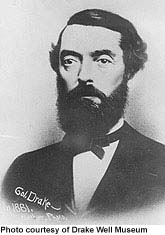|
|
Drake Commences Work At The Seep
Drake returned to Titusville again in 1858, this time as a salaried general agent of the Seneca Oil Company of Connecticut and in charge of operations at the seep. He held some stock in the company and already was a "Colonel", a salutary title given him by virtue of letters from the company being addressed to him in that fashion during his 1857 visit.
Edwin L. Drake's first activity was to try to put Angier's collection site back into operation and hopefully to improve it. The effort failed. The main seep produced only three or four gallons daily, sometimes six gallons per day on good days. If oil was going to be in demand, this small quantity certainly wouldn't meet it. Drake managed to increase the collected amount up to 10 gallons per day which still wasn't an economic yield. He also hired men to try to open up other springs (seeps) in the same area of the flats, but production did not significantly improve. After that Drake employed workmen to dig a shaft and thus try to mine the oil, but water entered in such quantity that the work couldn't continue. The failures of these inferior methods led to the drilling of a well in the fashion of the salt drillers, but Drake's well was carried out from the beginning with the sole intent of finding and producing crude oil. This pioneer enterprise proceeded with difficulty but was successful.
 |
The engine house of the Drake Well in 1861. Drake with top hat, standing (right). Peter Wilson, Drake's friend and druggist in Titusville. Photo from Drake Well Museum.
|
|
|
 |
Colonel L. Drake in 1861, about two years after his August 27, 1859, oil discovery via a drilled hole. John A Mather took this wet plate image in his Titusville studio. Photo courtesy of Drake Well Museum.
|
|
|

![]()

